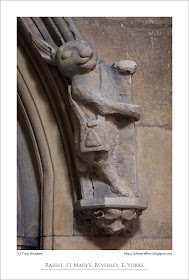 click photo to enlarge
click photo to enlargeI can't imagine that Charles Dodgson (1832-1898), a mathematics lecturer at Christ Church, Oxford, had an inkling of the fame and notoriety that he would achieve through his books, Alice's Adventures in Wonderland and Through the Looking Glass. These works, released under his pseudonym, Lewis Carroll, completely eclipsed any public acknowledgement that he received for his accomplishments in his professional and private life.
The larger than life characters that populate these two books have, through the printed word as well as through film and musical adaptations and references, become widely known. Where did Dodgson/Carroll get his inspiration for the Queen of Hearts, the March Hare, the Cheshire Cat and the rest of his cast? Well, in the case of the White Rabbit, there is the suggestion that it may have been in the medieval church of St Mary, in the market town of Beverley in East Yorkshire.
Last week I stood in the church and looked up at the carved stone label stop that terminates a raised hoodmoulding that edges the arch of a door. At the base is a head, facing downwards, which may be a pig, and standing upright on it is a fine rabbit. Around him is a satchel, an item that has caused some to call it the "Pilgrim Rabbit". We don't know the original reason for the medieval mason's decision to depict a man-like rabbit. But what we do know is that for much of the past hundred or so years the tradition has been that this rabbit inspired Lewis Carroll's "White Rabbit", the one that lured Alice down the rabbit-hole into her fantasy world. I don't know if there is any truth in this tale, nor I suppose, does anyone else. However, I think this is a very noteworthy rabbit, and one deserving of a photograph.
photograph and text (c) T. Boughen
Camera: Canon
Mode: Aperture Priority
Focal Length: 90mm
F No: f7.1
Shutter Speed: 1/40
ISO: 3200
Exposure Compensation: 0 EV
Image Stabilisation: N/A